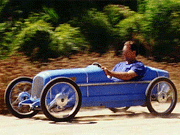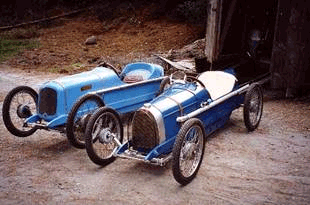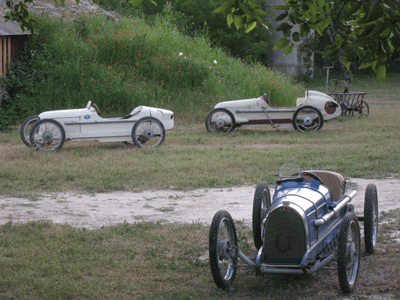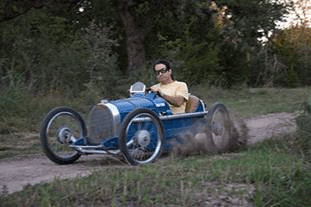
CycleKart

The Cyclekart is a small, go-kart type car with pre-WWII Grand Prix car styling. Its concept is rooted in the CycleCars of the early 20th century (~1910-1930s). The original Cyclecars were built as minimalist vehicles positioned between motorcycles and more expensive cars. They utilized motorcycle engines (Hence the "cycle" part of the name) instead of the multi-liter monsters found in touring cars of that era. They also had a minimalist chassis and simpler running gear compared to touring cars.
The modern Cyclekart has a two-rail frame with cross-members upon which is built a wooden or metal monocoque-type structure that imparts additional rigidity. It uses spoked motorcycle wheels all-around and is powered by a rear-mounted 6.5 HP Honda engine driving a single rear wheel through a Comet continuously variable transmission. The front of the car is suspended using leaf-springs and a tube beam axle, while the rear has no suspension. Many of the components are Azusa engineering kart parts, making sourcing them easier.

Cyclekarts (Courtesy of Michael Stevenson cyclekarts.com)
The philosophy of these cars extends beyond racing to art and nostalgia. Cyclekart creators Peter and Michael Stevenson intended the cars to be great looking, fun to drive and an expression of each builder. Many builders have created pre-war Bugattis, Delages, Alfas and Mercedes body styles but there is no restriction placed on styling (except perhaps safety).
Cyclekarts have been built and raced throughout the world. They are capable of racing on dirt or pavement courses.
| Power and Weight Stats | |
| Horsepower (Typical Range) | 6.5-6.5 |
| Race Weight (Typical Range) | 158-204 kg 350-450 lb |
Design and Construction
Build Your Own Cyclekart
Knowledge Level
Due to the scratch-built nature of Cyclekarts, you should be knowledgeable in basic handling, chassis, suspension and powertrain. The components are mostly spec parts so constructing a Cyclekart requires more knowledge of fabrication and assembly than design. Numerous examples of Cyclekart designs can be studied on the internet for ideas. Knowledge of welding is useful in fabricating the frame. Knowledge of woodworking, metalforming and possibly composites is useful in fabricating the bodywork.
Design Challenges

Cyclekarts (Courtesy of Michael Stevenson cyclekarts.com)
Weight Distribution:Front/rear weight distribution is not of significant importance as the compact layout dictates component placement. The engine is located behind the rear axle, while the driver is located between the axles with a rearward weight bias. Left/right weight distribution is almost 50/50 by virtue of the in-line car layout.
Suspension:The Cyclekart suspension is spec essentially. For the front, it uses 24" x 1 ¼" 2 leaf ½ elliptic springs to suspend a 1 5/8" diameter tube axle. Azusa brackets and spindles are welded to the axle. At the rear, it uses a solid axle with one wheel powered and the other allowed to freewheel on the axle. A single mechanical disc brake on the rear axle provides braking.
Chassis: Cyclekarts are generally built with 1"x3"x1/16" mild steel for the frame rails and cross-bracing. Ensure your design includes the brackets required to mount the bodywork, engine, brake caliper, pedals and steering column.
Bodywork Because much of the cyclekart's mechanicals are considered spec (keeping the cost low), the primary focus of Cyclekart design is the bodywork. Builders generally choose a pre-WWII grand prix type car or similar era car after which to model their car. Many different marques and cars have been modeled by builders so far, including Alfa, Delage, Bugatti and Mercedes. The bodywork structure is generally made of wood which acts as a chassis stiffener when mated with the steel frame below. To achieve the desired look, designers can use wood, foam/fiberglass or sheet metal to create complex shaped cowlings and bodywork. Scrounged parts like vent louvers can also be used to replicate parts originally used on early GP racers.

Cyclekart (Courtesy of Michael Stevenson cyclekarts.com)
Powertrain: Ventilating the engine is important for longevity of components especially around FRP or wood materials. Many Cyclekarts keep the top of the engine area open to the air. Fully enclosed engines should include ventilation.
Aerodynamic: While aerodynamics are not important for these cars due to their low speeds, many of the pre-WWII race cars that the Cyclekarts are modeled on had streamlined bodies.
Safety: Consideration should be given to securing critical fasteners with castellated nuts and safety wire to prevent failures of brakes, loss of wheels, or drivetrain components. This is good practice on any race car.
If you intend to race under a sanctioning body, always read and understand the regulations of your chosen racing class before designing or building any race vehicle.
Design Resources
Construction Challenges
Ensuring the chassis is dimensionally accurate and straight is important as flaws in the structure will create handling issues via misaligned suspension. The use of a solid, flat and level build space is important. Jigs are often used in this case to ensure that structural tubing stays in alignment during welding/brazing.
The builder should have solid joining and metal working knowledge and skills when fabricating the chassis/suspension. Mild steel (1018/1020) is recommended for frame rails and cross-members as it does not require heat treatment, provides good strength and has good machinability.
Having sufficient space for the chassis and bodywork construction is important, as a cramped workshop can be difficult to work in.
The tools to fabricate the chassis and bodywork can add considerably to the cost of your project if you don't already have them, but borrowing or renting items is also an option.
Build Costs
Most of the running gear is made up of off-the-shelf go-kart components so costs are kept low. The Cyclekart spec recommends cars cost no more than $1750 in 2001 US Dollars (~ $2300 USD in 2016 dollars).
Build Effort
The simplicity of the frame/chassis and overall car reduces the build effort in relation to other small race cars. The build is also made easier due to the large number of spec parts. The fabrication of the chassis, brackets and bodywork will likely require the most time.
Racing Cost
Cyclekarts are intended to be very low maintenance and so tires will likely be the main consumable. Damage to the car will likely be more costly in terms of time to repair than the actual costs of the repairs.
Transportation and Support Equipment
Trailering required.
(Images courtesy of Michael Stevenson. Cyclekarts.com)
198

